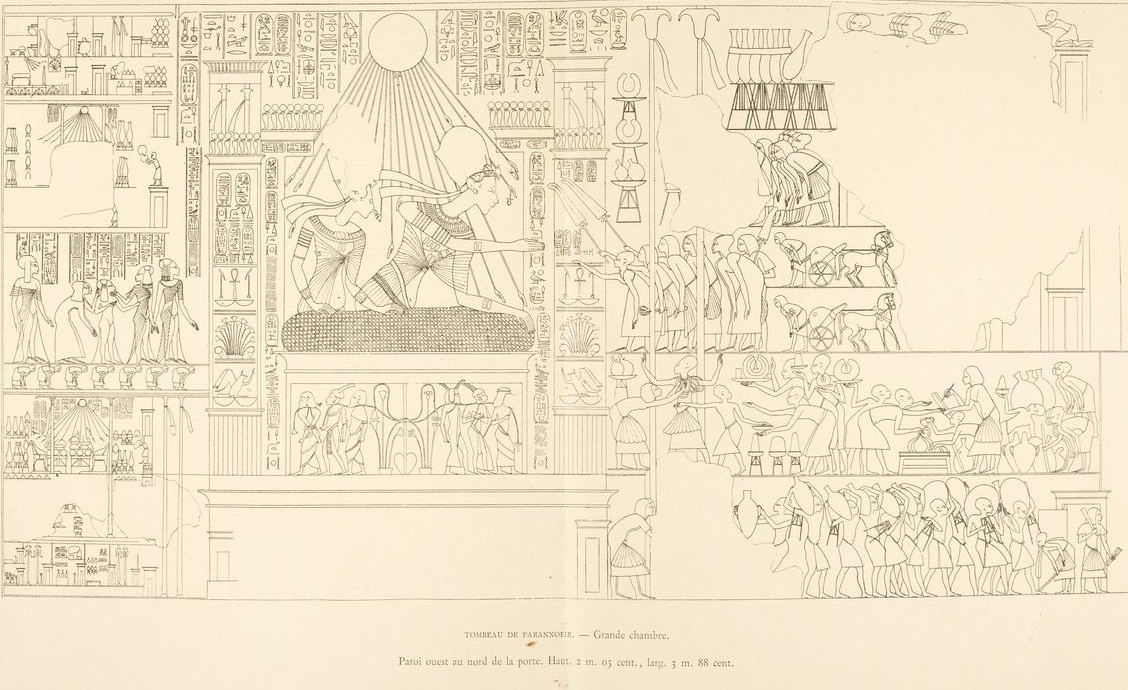Amarna Tomb 7 on:
[Wikipedia]
[Google]
[Amazon]
Amarna tomb 7 was one of the Southern tombs at Amarna, Egypt. It belonged to  On the West Wall an award scene shows Akhenaten and Nefertiti in the window of Appearances. The princesses
On the West Wall an award scene shows Akhenaten and Nefertiti in the window of Appearances. The princesses
Parennefer
The ancient Egyptian noble Parennefer was Akhenaten's close advisor before he came to the throne, and in later times served as his Royal Butler, an office which brought him into intimate contact with the king. His titles include "The King's Cup Be ...
, who was a pure handed cupbearer of the king's Person.
The facade of the tomb depicts scenes with Akhenaten
Akhenaten (pronounced ), also spelled Echnaton, Akhenaton, ( egy, ꜣḫ-n-jtn ''ʾŪḫə-nə-yātəy'', , meaning "Effective for the Aten"), was an ancient Egyptian pharaoh reigning or 1351–1334 BC, the tenth ruler of the Eighteenth D ...
, Nefertiti
Neferneferuaten Nefertiti () ( – c. 1330 BC) was a queen of the 18th Dynasty of Ancient Egypt, the great royal wife of Pharaoh Akhenaten. Nefertiti and her husband were known for a radical change in national religious policy, in which ...
, Meritaten
Meritaten, also spelled Merytaten, Meritaton or Meryetaten ( egy, mrii.t-itn) (14th century BC), was an ancient Egyptian royal woman of the Eighteenth Dynasty of Egypt. Her name means "She who is beloved of Aten"; Aten being the sun-deity whom h ...
, and Meketaten Meketaten ("Behold the Aten" or "Protected by Aten") was the second daughter of six born to the Egyptian Pharaoh Akhenaten and his Great Royal Wife Nefertiti. She likely lived between Year 4 and Year 14 of Akhenaten's reign. Although little is known ...
(and on the left Ankhesenpaaten
Ankhesenamun (, "Her Life Is of Amun"; c. 1348 or c. 1342 – after 1322 BC) was a queen who lived during the 18th Dynasty of Egypt as the pharaoh Akhenaten's daughter and subsequently became the Great Royal Wife of pharaoh Tutankhamun. Born Ank ...
) offering to the Aten
Aten also Aton, Atonu, or Itn ( egy, jtn, ''reconstructed'' ) was the focus of Atenism, the religious system established in ancient Egypt by the Eighteenth Dynasty pharaoh Akhenaten. The Aten was the disc of the sun and originally an aspect o ...
. Near the entrance Akhenaten, Nefertiti and three daughters offer to the deity Aten and in a nearby scene Parennefer offers a prayer.
 On the West Wall an award scene shows Akhenaten and Nefertiti in the window of Appearances. The princesses
On the West Wall an award scene shows Akhenaten and Nefertiti in the window of Appearances. The princesses Meritaten
Meritaten, also spelled Merytaten, Meritaton or Meryetaten ( egy, mrii.t-itn) (14th century BC), was an ancient Egyptian royal woman of the Eighteenth Dynasty of Egypt. Her name means "She who is beloved of Aten"; Aten being the sun-deity whom h ...
, Meketaten Meketaten ("Behold the Aten" or "Protected by Aten") was the second daughter of six born to the Egyptian Pharaoh Akhenaten and his Great Royal Wife Nefertiti. She likely lived between Year 4 and Year 14 of Akhenaten's reign. Although little is known ...
, Ankhesenpaaten
Ankhesenamun (, "Her Life Is of Amun"; c. 1348 or c. 1342 – after 1322 BC) was a queen who lived during the 18th Dynasty of Egypt as the pharaoh Akhenaten's daughter and subsequently became the Great Royal Wife of pharaoh Tutankhamun. Born Ank ...
and the Queen's Sister Mutbenret
Mutbenret (''Benretmut'') was an Egyptian noblewoman, and said to be the sister of the Great Royal Wife Nefertiti. Her name used to be read as Mutnedjemet. The hieroglyphs for ''nedjem'' and ''bener'' are similar and so is their meaning. The name ...
(sometimes referred to as Mutnodjemet or Mutnedjmet
Mutnedjmet, also spelled Mutnedjemet, Mutnodjmet, Mutnodjemet ( egy, mw.t-nḏm.t) was an ancient Egyptian queen, the Great Royal Wife of Horemheb, the last ruler of the 18th Dynasty. The name, Mutnedjmet, translates as: ''The sweet Mut.''
Ti ...
) are shown in the palace in a room behind the window. Parennefer is shown receiving many gifts from the royal family, followed by a trip back to his house among celebrating crowds. He is shown being received at the gates of his own house by his wife (whose name was lost), but was said to be a favorite of the King's Chief Wife Neferneferuaten-Nefertiti
Neferneferuaten Nefertiti () ( – c. 1330 BC) was a queen of the 18th Dynasty of Ancient Egypt, the great royal wife of Pharaoh Akhenaten. Nefertiti and her husband were known for a radical change in national religious policy, in which ...
.
The East Wall contains a scene where the King gives an audience to Parennefer. Akhenaten, Nefertiti and one of their daughter are shown in a kiosk, while Parennefer and a servant appear before the royal family. The servant offers ointment, while Parennefer offers a speech. Several courtiers and musicians are shown attending with several tables with food and drink presented in the scene.Murnane, William J., Texts from the Amarna Period in Egypt, Society of Biblical Literature, 1995
References
Amarna tombs {{AncientEgypt-stub